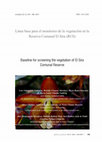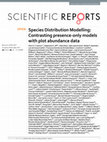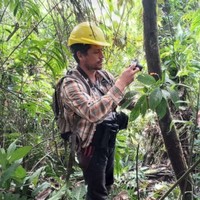Papers by Luis Valenzuela Gamarra

Global Ecology and Biogeography
AimTo investigate the geographic patterns and ecological correlates in the geographic distributio... more AimTo investigate the geographic patterns and ecological correlates in the geographic distribution of the most common tree dispersal modes in Amazonia (endozoochory, synzoochory, anemochory and hydrochory). We examined if the proportional abundance of these dispersal modes could be explained by the availability of dispersal agents (disperser‐availability hypothesis) and/or the availability of resources for constructing zoochorous fruits (resource‐availability hypothesis).Time periodTree‐inventory plots established between 1934 and 2019.Major taxa studiedTrees with a diameter at breast height (DBH) ≥ 9.55 cm.LocationAmazonia, here defined as the lowland rain forests of the Amazon River basin and the Guiana Shield.MethodsWe assigned dispersal modes to a total of 5433 species and morphospecies within 1877 tree‐inventory plots across terra‐firme, seasonally flooded, and permanently flooded forests. We investigated geographic patterns in the proportional abundance of dispersal modes. We ...

Communications Biology
Using 2.046 botanically-inventoried tree plots across the largest tropical forest on Earth, we ma... more Using 2.046 botanically-inventoried tree plots across the largest tropical forest on Earth, we mapped tree species-diversity and tree species-richness at 0.1-degree resolution, and investigated drivers for diversity and richness. Using only location, stratified by forest type, as predictor, our spatial model, to the best of our knowledge, provides the most accurate map of tree diversity in Amazonia to date, explaining approximately 70% of the tree diversity and species-richness. Large soil-forest combinations determine a significant percentage of the variation in tree species-richness and tree alpha-diversity in Amazonian forest-plots. We suggest that the size and fragmentation of these systems drive their large-scale diversity patterns and hence local diversity. A model not using location but cumulative water deficit, tree density, and temperature seasonality explains 47% of the tree species-richness in the terra-firme forest in Amazonia. Over large areas across Amazonia, residuals...

In a time of rapid global change, the question of what determines patterns in species abundance d... more In a time of rapid global change, the question of what determines patterns in species abundance distribution remains a priority for understanding the complex dynamics of ecosystems. The constrained maximization of information entropy provides a framework for the understanding of such complex systems dynamics by a quantitative analysis of important constraints via predictions using least biased probability distributions. We apply it to over two thousand hectares of Amazonian tree inventories across seven forest types and thirteen functional traits, representing major global axes of plant strategies. Results show that constraints formed by regional relative abundances of genera explain eight times more of local relative abundances than constraints based on directional selection for specific functional traits, although the latter does show clear signals of environmental dependency. These results provide a quantitative insight by inference from large-scale data using cross-disciplinary ...
ABSTRACT: The sensitivity of tropical forest carbon to climate is a key uncertainty in predicting... more ABSTRACT: The sensitivity of tropical forest carbon to climate is a key uncertainty in predicting global climate change. Although short-term drying and warming are known to affect forests, it is unknown if such effects translate into long-term responses. Here, we analyze 590 permanent plots measured across the tropics to derive the equilibrium climate controls on forest carbon. Maximum temperature is the most important predictor of aboveground biomass (−9.1 megagrams of carbon per hectare per degree Celsius), primarily by reducing woody productivity, and has a greater rate of decline in the hottest forests (>32.2°C). Our results nevertheless reveal greater thermal resilience than observations of short-term variation imply. To realize the long-term climate adaptation potential of tropical forests requires both protecting them and stabilizing Earth's climate.
Amazonian forests are extraordinarily diverse, but the estimated species richness is very much de... more Amazonian forests are extraordinarily diverse, but the estimated species richness is very much debated.
Here, we apply an ensemble of parametric estimators and a novel technique that includes conspecifc spatial aggregation to an extended database of forest plots with up-to-date taxonomy. We show that
the species abundance distribution of Amazonia is best approximated by a logseries with aggregated individuals, where aggregation increases with rarity. By averaging several methods to estimate total richness, we confrm that over 15,000 tree species are expected to occur in Amazonia. We also show that using ten times the number of plots would result in an increase to just ~50% of those 15,000 estimated species. To get a more complete sample of all tree species, rigorous feld campaigns may be needed but
the number of trees in Amazonia will remain an estimate for years to come.
Journal of Plant Sciences

La Amazonía abarca un área de aproximada de 6.8 millones km² situada en la parte norte de América... more La Amazonía abarca un área de aproximada de 6.8 millones km² situada en la parte norte de América del Sur (Eva et al., 2005). Los bosques húmedos cubren casi el 80% de la Amazonía (5.5 millones de km²) y el restante 20%, está cubierto por bosques secos (1%), bosques inundados (3%), herbazales y matorrales (5%), vegetación escasa (1%), así como por agricultura y áreas urbanas (10%). La región Madre de Dios, ha revelado altos niveles de diversidad biológica con sitios singulares, teniendo récords mundiales para especies de aves (en más de 600) y varios grupos de insectos (por lo menos 1250 mariposas, 150 libélulas) (Lamas 1994; Parker et al. 1994). La flora es casi tan excepcional como la diversidad de fauna, con más de 1000 especies de árboles registradas en el área de estudio (Phillips et al. 2003b). La Universidad Andina del Cusco, Licenciada por SUNEDU, acreditada internacionalmente y considerada Paradigmática, cuyo fin supremo es la formación académica, la investigación y la resp...

Science, 2013
Introduction Recent decades have seen a major international effort to inventory tree communities ... more Introduction Recent decades have seen a major international effort to inventory tree communities in the Amazon Basin and Guiana Shield (Amazonia), but the vast extent and record diversity of these forests have hampered an understanding of basinwide patterns. To overcome this obstacle, we compiled and standardized species-level data on more than half a million trees in 1170 plots sampling all major lowland forest types to explore patterns of commonness, rarity, and richness. Methods The ~6-million-km 2 Amazonian lowlands were divided into 1° cells, and mean tree density was estimated for each cell by using a loess regression model that included no environmental data but had its basis exclusively in the geographic location of tree plots. A similar model, allied with a bootstrapping exercise to quantify sampling error, was used to generate estimated Amazon-wide abundances of the 4962 valid species in the data set. We estimated the total number of tree species in the Amazon by fitting t...
FIGURE 5. Ceroxylon ravenii. A: Inflorescence branches with old staminate flowers; B: Pistillate ... more FIGURE 5. Ceroxylon ravenii. A: Inflorescence branches with old staminate flowers; B: Pistillate inflorescence at bud stage; C: Pistillate inflorescence showing flowers in bud; D: Staminate inflorescence; E: Staminate flower; F: Pistillate flowers at bus stage; G: Infructescence; H: Fruit; I: Seed; J: Embryo. (Images: L. Valenzuela).
FIGURE 3. Ceroxylon ravenii. A: Habit; B: Middle pinna tips; C: Basal pinna tips; D: Pistillate f... more FIGURE 3. Ceroxylon ravenii. A: Habit; B: Middle pinna tips; C: Basal pinna tips; D: Pistillate flower; E: Insertion of staminodes; F: Gynoecium; G: Infructescence; H: Fruit; I: Staminate flower; J: Insertion of stamens. (Drawings of pistillate parts from: L. Valenzuela 35737A, L. Valenzuela 35737B, staminate parts: L. Valenzuela 33565).
Polylepis rodolfo-vasquezii, a new species of the Rosaceae family, is described and illustrated; ... more Polylepis rodolfo-vasquezii, a new species of the Rosaceae family, is described and illustrated; from the buffer area of the Bosque de Proteccion Pui-Pui, Region of Junin, province of Satipo, Peru. This species is similar to P. subsericans, which is characterized by leaves with 1-3 pairs of leaflets and flexuose petioles; inflorescence pendulous 3-4 cm in length and 4 flowers with 3-4 sepals; cylindrical fruit with irregularly flattened spines. In contrast, P. rodolfo-vasquezii has leaves with only 3 leaflets; inflorescence 1-flowered, erect; flowers with 3 sepals and fruits oblong with three slightly flattened ridges.

Arnaldoa, 2015
Polylepis rodolfo-vasquezii , a new species of the Rosaceae family, is described and illustrated;... more Polylepis rodolfo-vasquezii , a new species of the Rosaceae family, is described and illustrated; from the buffer area of the Bosque de Proteccion Pui Pui, region of Junin, province of Satipo, Peru. This species is similar to P. subsericans , which is characterized by leaves with 1-3 pairs of leaflets and flexuose petioles; inflorescence pendulous 3-4 cm in length and 4 flowers with 3-4 sepals; cylindrical fruit with irregularly flattened spines. In contrast, P. rodolfo-vasquezii has leaves with only 3 leaflets; inflorescence 1-flowered, erect; flowers with 3 sepals and fruits oblong with three slightly flattened ridges. Keywords: buffer area, Bosque de Proteccion Pui Pui, Polylepis , Rosaceae, inflorescence 1-flowered, Andes, Peru. Resumen Polylepis rodolfo-vasquezii , una nueva especie de la familia Rosaceae, es descrita e ilustrada; proveniente de la zona de amortiguamiento del Bosque de Proteccion Pui Pui, region de Junin, provincia de Satipo, Peru. La especie es similar a Polyl...
Global Ecology and Biogeography, 2020
This is an open access article under the terms of the Creat ive Commo ns Attri bution License, wh... more This is an open access article under the terms of the Creat ive Commo ns Attri bution License, which permits use, distribution and reproduction in any medium, provided the original work is properly cited.

Arnaldoa, 2015
Registramos a 729 especies agrupadas en 120 familias con 398 generos entre arboles, lianas, arbus... more Registramos a 729 especies agrupadas en 120 familias con 398 generos entre arboles, lianas, arbustos, hierbas, hemiepifitos y epifitos. Caracterizamos la vegetacion del area en cinco tipos de bosque: Llanura amazonica, Transicional pre-Montano, pre-Montano, Nublado o Montano alto y el Esclerofilo; sobre ellos establecimos, 6 parcelas permanentes con la finalidad de implementar un sistema de monitoreo de la dinamica de los bosques. El mayor contenido de biomasa aerea se halla sobre el bosque transicional pre-Montano con 264 T/ha. La vegetacion sobre el llano amazonico aparentemente presenta una dinamica mas estable, donde las tasas de reclutamiento y mortalidad fluctuan entre los 2.4 y 2%. La mayor diversidad vegetal ocurre sobre los bosques de Llanura amazonica. El mayor area basal ocupado por los individuos de la parcela III, con 31.7 m², un area menor es ocupado por los arboles de la parcela IV con solo 3 m². La estructura horizontal, esta dado mayormente por arboles cuyos diametr...
Lankesteriana, 2013
A new species of Ponthieva was found in the mountains of Yanachaga Chemillén, on a pre-montane fo... more A new species of Ponthieva was found in the mountains of Yanachaga Chemillén, on a pre-montane forest at 1400 m in the central jungle of Peru. It is similar to P. pilosissima, but can be distinguished by the presence of a callus on the lip and by the color of the petals, which are boldly veined in P. pilosissima and inconspicuously striped in P. hermiliae.
Lankesteriana, 2008
Masdevallia vilcabambensis, a new species from the department of Cuzco in Peru, is described and ... more Masdevallia vilcabambensis, a new species from the department of Cuzco in Peru, is described and illustrated. It is similar to M. minuta, but it has much smaller plants and flowers, the flowers are yellowish and blotched with purple, and the sepals abruptly reflexed at the middle. Also, M. vilcabambensis is exclusively know from around 2500 meters elevation, whilst M. minuta is restricted to warm regions below 350 meters of altitude.

A new species of Scaphosepalum was found in the mountains of Yanachaga-Chemillen National Park, i... more A new species of Scaphosepalum was found in the mountains of Yanachaga-Chemillen National Park, in a humid montane forest at 2300 m in the central jungle of Peru. This species is similar to Scaphosepalum antenniferum but can be differentiated because the lateral sepals exhibit rhomboidal cushions and the lip is spathuliform. In contrast, the lateral sepals of S. antenniferum show broad lunar cushions and the medium sepal with apiculate apex; on the other hand, the lip is subpanduriform and with denticulate apex. Keywords: Orchidaceae, Pleurothallidinae, Scaphosepalum , new species, central jungle, Oxapampa, Yanachaga-Chemillen National Park, Peru. Resumen Se encontro una nueva especie de Scaphosepalum en las montanas del Parque Nacional Yanachaga-Chemillen, en un bosque humedo montano a 2300 m de altitud en la Selva Central del Peru. Esta especie es similar a Scaphosepalum antenniferum pero se diferencia porque sus sepalos laterales presentan cojines romboidales y el labelo es espat...

Species distribution models (SDMs) are widely used in the fields of macroecology, biogeography an... more Species distribution models (SDMs) are widely used in the fields of macroecology, biogeography and biodiversity research for modelling species geographic distributions based on correlations between known occurrence records and the environmental conditions at occurrence localities1,2. SDMs generate geographical maps of a species’ environmental suitability, its likelihood of being collected, and its local abundance3. Their application includes selecting conservation areas, predicting the effects of climate change on species ranges and determining the risk of species invasions. The wide use of SDMs in ecological and conservation research can partly be explained by the growing availability of georeferenced species records (e.g. GBIF, SpeciesLink) and environmental data (e.g. WorldClim, CliMond) on the web, together with the user-friendly character of some of the modelling methods. One of the most commonly used SDMs is MaxEnt, which has become increasingly popular since its introduction....

Nature Communications
The carbon sink capacity of tropical forests is substantially affected by tree mortality. However... more The carbon sink capacity of tropical forests is substantially affected by tree mortality. However, the main drivers of tropical tree death remain largely unknown. Here we present a pan-Amazonian assessment of how and why trees die, analysing over 120,000 trees representing > 3800 species from 189 long-term RAINFOR forest plots. While tree mortality rates vary greatly Amazon-wide, on average trees are as likely to die standing as they are broken or uprooted—modes of death with different ecological consequences. Species-level growth rate is the single most important predictor of tree death in Amazonia, with faster-growing species being at higher risk. Within species, however, the slowest-growing trees are at greatest risk while the effect of tree size varies across the basin. In the driest Amazonian region species-level bioclimatic distributional patterns also predict the risk of death, suggesting that these forests are experiencing climatic conditions beyond their adaptative limit...










Uploads
Papers by Luis Valenzuela Gamarra
Here, we apply an ensemble of parametric estimators and a novel technique that includes conspecifc spatial aggregation to an extended database of forest plots with up-to-date taxonomy. We show that
the species abundance distribution of Amazonia is best approximated by a logseries with aggregated individuals, where aggregation increases with rarity. By averaging several methods to estimate total richness, we confrm that over 15,000 tree species are expected to occur in Amazonia. We also show that using ten times the number of plots would result in an increase to just ~50% of those 15,000 estimated species. To get a more complete sample of all tree species, rigorous feld campaigns may be needed but
the number of trees in Amazonia will remain an estimate for years to come.
Here, we apply an ensemble of parametric estimators and a novel technique that includes conspecifc spatial aggregation to an extended database of forest plots with up-to-date taxonomy. We show that
the species abundance distribution of Amazonia is best approximated by a logseries with aggregated individuals, where aggregation increases with rarity. By averaging several methods to estimate total richness, we confrm that over 15,000 tree species are expected to occur in Amazonia. We also show that using ten times the number of plots would result in an increase to just ~50% of those 15,000 estimated species. To get a more complete sample of all tree species, rigorous feld campaigns may be needed but
the number of trees in Amazonia will remain an estimate for years to come.